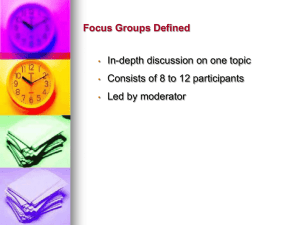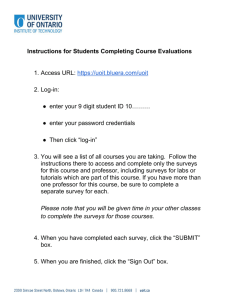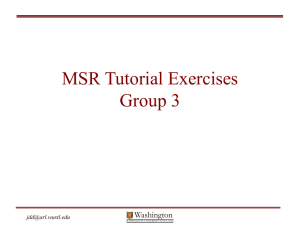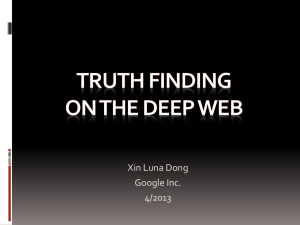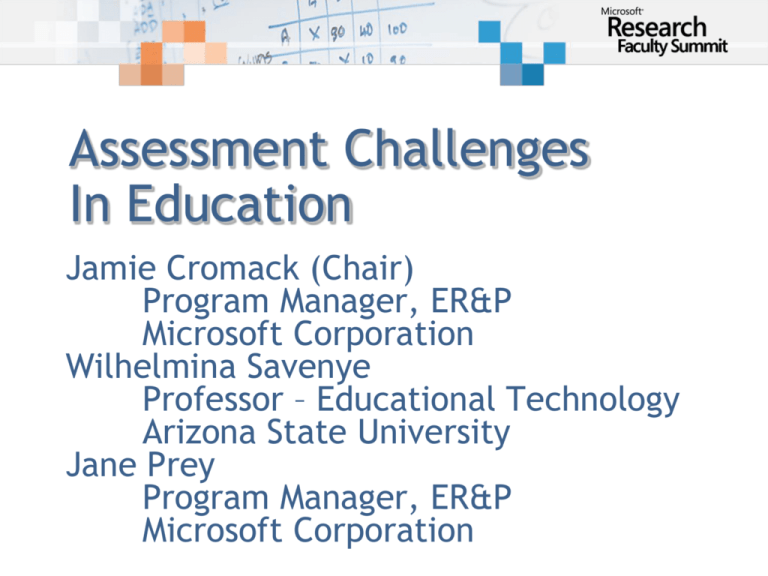
Assessment Challenges
In Education
Jamie Cromack (Chair)
Program Manager, ER&P
Microsoft Corporation
Wilhelmina Savenye
Professor – Educational Technology
Arizona State University
Jane Prey
Program Manager, ER&P
Microsoft Corporation
Agenda
Introducing the MSR Assessment Toolkit
Background and goals
Brief overview of the Toolkit
Discussion of assessment challenges
Background
What is the MSR Assessment Toolkit?
The Assessment Toolkit is a unique
resource for CS, Engineering, other
STEM faculty
Though many web-based resources exist,
none will do what this MSR tool will
A partnership among MSR and leading
faculty in assessment and faculty in
Computing Science, Science, Science,
Technology, Engineering and Mathematics
(STEM) disciplines
MSR Faculty Summit Packet
White Paper
Learning about Learning in
Computational Science and Science,
Technology, Engineering and Mathematics
(STEM) Education
J. Cromack and W. Savenye, 2007
Background
Why was the MSR Assessment Toolkit
developed?
Faculty must do assessment; few have the
time, training, and support to do it as
well as they would like
STEM faculty are very interested in using
the MSR Assessment Toolkit
Background
Why has assessment become increasingly
important?
External factors – trends:
Accountability/accreditation
Funding agency requirements
Funding and enrollment issues
Changes in pedagogy, instructional design
Internal factors – collect data to:
Improve educational experience for students
Motivate students
Microsoft Research
AssessmentToolkit
Developed by:
Willi Savenye and Gamze Ozogul,
Arizona State University
Jamie Cromack,
EP&R, MSR
The MSR Assessment Toolkit
The Assessment Toolkit consists of a set
of assessment resources designed to aid
faculty in building stronger measures of
the success of their projects, during all
phases of their projects’ life cycles
Version 1 now deployed
We are looking forward to your feedback
MSR AssessmentToolkit
Components
1. Assessment Planning Overview
2. Assessment FAQs
3. User Grid to help faculty determine
which resources might be most useful for
their level of assessment experience.
4. Assessment Methods Selection Guide
5. Focused Assessment Resources
(an annotated bibliography)
6. Case Studies in Effective Assessment
MSR AssessmentToolkit
Components
1. Assessment Planning Overview
2. Assessment FAQs
3. The User Grid
What level of assessment user are you?
BASIC (B)
TYPICAL (T)
POWER
(P)
If you :
Want to know more about how
students learn in or experience your
class
Have generally administered only
the university-constructed end-ofterm student surveys
Have not used a rubric to grade an
assignment
If you have done some of:
Have thought about specific
learning goals or outcomes for your
class
Have thought about the overall
goals of your curriculum and how it
prepares students
Supplemented the universityconstructed end-of-term surveys
with simple mid-term surveys
Done minute papers or fastfeedback sheets
Have used pre-designed rubrics
with minimal adaptation
If you
Seek to define and describe in detail
student experience with learning
goals in your classroom
Seek to define and describe in detail
student preparation as experienced
through your curriculum
Have regularly administered
pre/post surveys, mid-term surveys
and end-of-term surveys
Have created from scratch or
significantly adapted a rubric for
grading
Have reported on qualitative or
quantitative results of studies of
student understanding in peerreviewed literature venues
4. Assessment Methods
Selection Guide
As faculty begin to select their assessment
methods, they should consider making sure that
they measure:
Student Performance,
Satisfaction, and
Retention (if desired)
Include a balance of both direct and indirect
measures, as well as both formative measures
(to improve instruction in process) and
summative measures (to make evaluative
decisions at or near the end of the project)
4. Assessment Methods
Selection Guide
Direct (observable phenomena)
Indirect (self-report data)
Summative
(accountability,
retroactive,
evaluative)
Exams & quizzes (may be used pre- and postcourse)
Projects & assignments (often evaluated using
rubrics/checklists)
Student performance on case studies
Final grades
Concept maps/flowcharts
Observations (often using rubrics/checklists)
Portfolios
Capstone projects
Course/test embedded assessment
Outcomes assessment (often using
rubrics/checklists)
Demonstration of a skill (often using
rubrics/checklists)
Exit surveys
Exit interviews
End of term survey
Student ratings
Interviews
Formative (decision
making,
proactive,
diagnostic)
Exams & quizzes (may be used pre- and postcourse)
Projects & assignments (often evaluated using
rubrics/checklists)
Student performance on case studies
Mid-course and assignment grades
Concept maps/flowcharts
Observations (often using rubrics/checklists)
Background knowledge probes
Minute or fast-feedback papers
Student-generated test questions
Diagnostic learning logs or journals
Muddiest point surveys
Satisfaction surveys
Attitude surveys
Mid-semester feedback surveys
Student ratings
Interviews
Methods For Measuring Student Performance
And Retention: (E.g., a short selection)
Method
User
level
Class
Size
Type
Description
Strengths
Limitations
Example
question(s)
Constructed
responsemultiple
choice
items
(performan
ce,
retention)
B, T,
P
La
F/S
Used to gather data about
student performance and
level of mastery of the
course content. Can be used
in pretest and posttest
forms administered at the
beginning of the course and
again at the end.
• Can cover broad
scope of
content
• Objective
assessment
• Easy to score
• Reusable
• Reliability and
validity
concerns
• Time consuming
to build
• Answers limited
to constructed
responses
• Which one
below is a
type of
processing?
A) Batch
B) Series
C) Network
D) Distributed
Short
answer
items
(performan
ce/
retention)
B, T
La
F/S
Used to gather data about
student knowledge about a
topic Can be used in pretest
and posttest forms
administered at the
beginning of the course and
again at the end.
• Easy to prepare
• Reusable
• Easy to score
• Limited number
of questions
• Limited scope
of content
What is an
algorithm?
Grades
(mid-course
or final
grades)
(performan
ce or
retention)
B, T,
P
La/
Sm
F/S
Collected on projects,
assignments, quizzes, etc.
mid-course, as well as
collected at the end of the
course.
• Easy to collect,
as necessary
• Can be tracked
over multiple
courses over
time
• May not be finegrained enough
to yield
differences
• Influenced by
many factors in
addition to
course
innovations
• Grade book
entries
METHODS FOR MEASURING STUDENT SATISFACTION
(Eg. a short selection)
Instrument
User
level
Class
Size
Type
Description
Strengths
Limitations
Example
question(s)
Attitude
surveys
(satisfaction)
B,
T,P
La/
Sm
F/S
Provide data about students’
perceptions about a
topic/class. Can be used to
make formative or summative
decisions depending on the
time of administration.
Generally Likert type
questions; may be followed by
a few open-ended questions.
May be used as a pre/post
measure.
• Easy to
administer
• Cover many
areas of
attitude
• Can be used
in large
groups
• Do not provide
in- depth
information
about attitudes
• The course
projects were
difficult for
me.
• Strongly
agree, agree,
disagree,
strongly
disagree
Happy sheets
(satisfaction)
B
La
F
Provide data about students’
perceptions. Generally used to
make formative decisions; can
be given at the end of any
class or seminar. Likert-type or
open-ended questions.
• Easy to
prepare and
administer
• Provide
specific and
fast feedback
on a class
session
• Limited
number of
questions
• This session
was useful to
me:
• Agree
• Neutral
• Disagree
Open-ended
questionnair
es
(satisfaction)
B, T
Sml/S
mpl
F/S
Provide data about students’
perceptions in detail on a
specific topic. Open ended
questions.
• Easy to
prepare
• Collect
detailed
information.
• Suitable for
smaller groups
• It takes time to
analyze
responses to
each openended question
• Limited
number of
questions
• What did you
like the most
(and least)
about the
materials
used in this
session?
5. Focused Assessment Resources
Annotated, responsive to user needs
Selected books and articles on assessment
focusing on Engineering and Computer Science
Education
Online “HANDBOOKS” on Assessment and
Evaluation
Web Sites of Professional Organizations Offering
Resources on Assessment and Evaluation
Other Useful Evaluation and Assessment
Web Sites
Selected Books on Learning and
Instructional Planning
Online Journal on Assessment and Evaluation
6. Case Studies In Effective
Assessment
6. Case Studies in Effective
Assessment
Mark Guzdial
Professor of Computer Science
Georgia Tech
Example of Comprehensive Assessment
Projects, adapted at many universities
Human Subjects – consent letter
Pre-course surveys
Post-course surveys
Interview protocols
Grades
Discussion Of Assessment Challenges
Introduction
Dr. Jane Prey and Dr. Jamie Cromack
MSR, ER&P
Open Discussion – Participants
What are your and your colleagues’
important assessment challenges?
MSR Assessment Toolkit
http://research.microsoft.com/erp/AssessmentToolkit
We welcome your input!
© 2007 Microsoft Corporation. All rights reserved. Microsoft, Windows, Windows Vista and other product names are or may be registered trademarks and/or trademarks in the U.S. and/or other
countries. The information herein is for informational purposes only and represents the current view of Microsoft Corporation as of the date of this presentation. Because Microsoft must respond to
changing market conditions, it should not be interpreted to be a commitment on the part of Microsoft, and Microsoft cannot guarantee the accuracy of any information provided after the date of
this presentation. MICROSOFT MAKES NO WARRANTIES, EXPRESS, IMPLIED OR STATUTORY, AS TO THE INFORMATION IN THIS PRESENTATION.
Microsoft Research
Faculty Summit 2007


